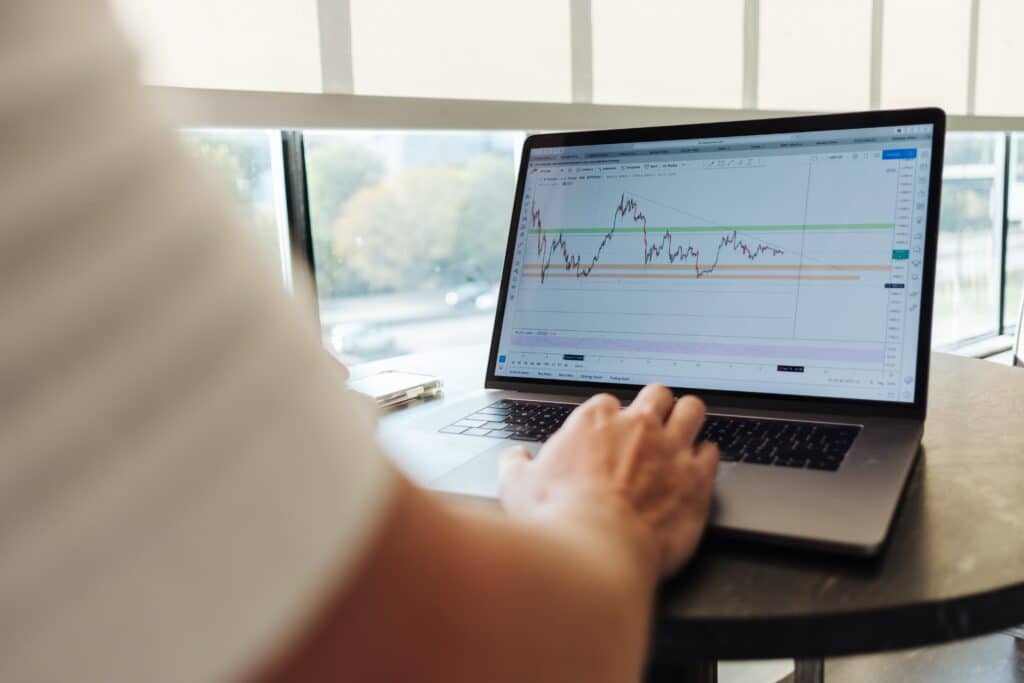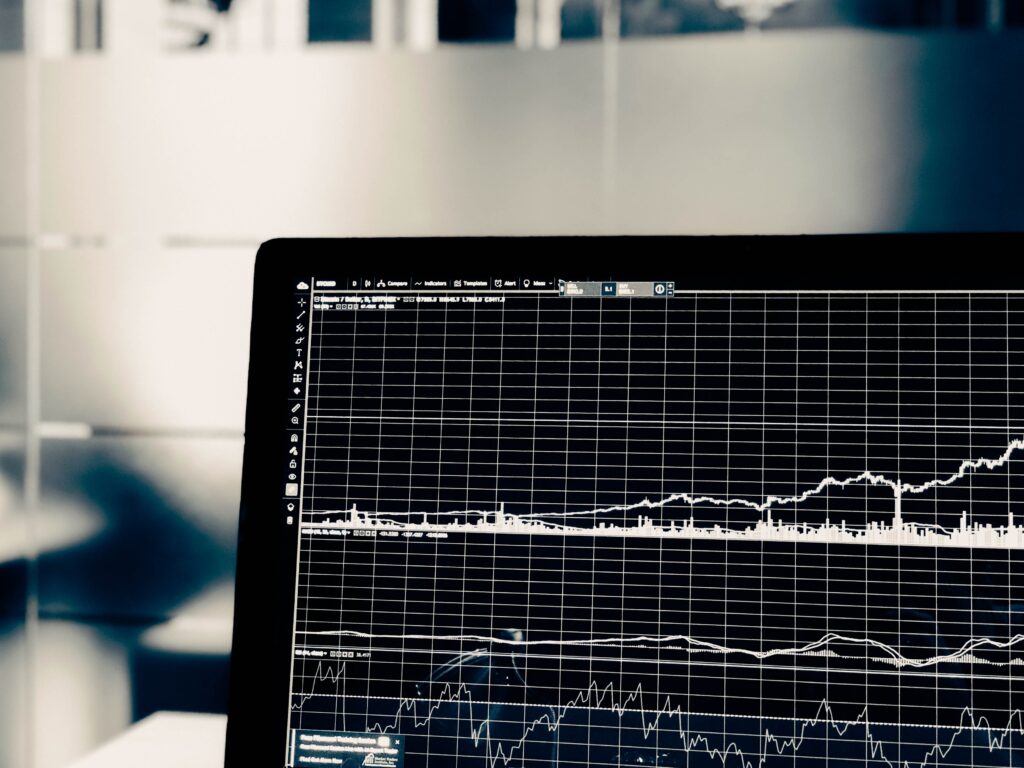A Guide to Trading in the UK
Thousands of books have been written about trading over the years. As you may well appreciate, it is a subject that has a multitude of factors that can influence success or failure.
Traders in the UK have many things to consider when getting started. In this report, we will cover as many of them as we can. We will look at trading styles, analysis techniques, some strategies and also a few trading essentials. Hopefully, this can help you on your way to becoming a more successful trader.

Day Trading vs Investing
We will start with a look at time horizons. The time horizons of your trades will play a role in the analysis techniques, markets and perhaps even the products that you trade.
Day trading and investing are two distinct approaches to buying and selling securities in financial markets, each with its characteristics and goals.
Day trading refers to the practice of buying and selling securities, such as stocks or currencies, within the same trading day, to profit from short-term price movements. Day traders typically rely on technical analysis, using charts and other tools to identify patterns and trends in prices and execute trades based on their analysis.
Investing, on the other hand, is a long-term strategy aimed at building wealth over time. Investors typically buy and hold securities for extended periods, to benefit from the growth and appreciation of their investments. They often focus on fundamental analysis, examining the financial health and performance of stocks, commodities or currencies. They make decisions based on their analysis of the long-term prospects of the investment.
While both day trading and investing involve buying and selling securities, they differ in their timeframes, strategies, and goals. Day traders seek to profit from short-term price movements, often taking advantage of leverage and other tools to amplify their gains. Investing, on the other hand, is a more conservative approach, focused on long-term growth and stability, with a focus on risk management and diversification.
Broad trading styles

On a basic level, there are around four different trading styles that can be incorporated as part of a trading strategy. They run over various time horizons, from ultra short-term trading to very long-term buy and hold strategies. Here’s what they are:
- Scalping
- Day Trading
- Swing Trading
- Position Trading
Scalping
Scalping is a very short-term trading strategy that involves buying and selling securities quickly, often within seconds or minutes, to profit from small price movements. Scalping traders typically execute multiple trades each day, seeking to accumulate small gains that can add up to significant profits over time.
Scalping traders rely on technical analysis, using charts and other tools to identify short-term trends and patterns in prices. They often use leverage to amplify their gains and may focus on highly liquid securities, such as currencies, stocks, or futures contracts.
The aim is to take advantage of small price movements by entering and exiting positions quickly, often using market orders to execute trades instantly. They may use tight stop-loss orders to limit losses and often use high-frequency trading strategies to maximize their speed and efficiency.
Scalping trading can be highly profitable, but it also involves significant risk. Scalping traders must be disciplined and have a thorough understanding of the markets, as well as the tools and strategies they use. They must also be able to manage their emotions and avoid impulsive decisions that can lead to losses.
Day Trading
Day trading is a strategy of buying and selling securities within the same trading day, to profit from short-term price movements. Day traders typically use technical analysis, using charts and other tools to identify patterns and trends in prices and execute trades based on their analysis.
Day traders aim to take advantage of intraday price volatility by entering and exiting positions quickly, often within minutes or hours. They may use leverage to amplify their gains and often focus on highly liquid securities, such as stocks, currencies, or futures contracts.
Day traders must have a thorough understanding of the markets, as well as the tools and strategies they use. They must be able to manage their risk, using stop-loss orders to limit losses and position sizing to manage their exposure. They must also be able to manage their emotions and avoid impulsive decisions that can lead to losses.
Day trading can be highly profitable, but it also involves significant risk. It requires discipline, focus, and a thorough understanding of the markets, as well as the ability to adapt to changing market conditions. Day traders must be willing to constantly learn and improve their strategies to succeed.
Swing Trading
Swing trading is a strategy of holding positions for a short period, typically several days to a few weeks, to profit from price movements that occur during that time. Swing traders typically use technical analysis, using charts and other tools to identify patterns and trends in prices, and execute trades based on their analysis.
Swing traders aim to take advantage of medium-term price movements by identifying stocks or other securities such as commodities or currencies that are likely to move in a particular direction based on technical indicators. They may use fundamental analysis to identify companies with strong growth potential or favourable market conditions but typically focus on technical analysis.
Swing traders must have a thorough understanding of the markets, as well as the tools and strategies they use. They must be able to manage their risk, using stop-loss orders to limit losses and position sizing to manage their exposure. They must also be able to manage their emotions and avoid impulsive decisions that can lead to losses.
Swing trading can be highly profitable, but it also involves significant risk. It requires discipline, focus, and a thorough understanding of the markets, as well as the ability to adapt to changing market conditions. As with day trading, swing traders must be willing to constantly learn and improve their strategies to succeed. Read more about Swing Trading.
Position Trading
Position trading is a long-term trading strategy that involves buying and holding securities for an extended period, typically several months to several years, to profit from long-term price movements. Position traders typically use fundamental analysis, using financial statements and other indicators to assess a company’s growth potential, competitive position, and overall health.
Position traders aim to take advantage of long-term trends in the markets by identifying companies with strong fundamentals and holding their positions for an extended period. They may use technical analysis to identify entry and exit points but typically focus on fundamental analysis.
Position traders must have a thorough understanding of the markets, as well as the tools and strategies they use. They must be able to manage their risk, using diversification and position sizing to manage their exposure. They must also be able to manage their emotions and avoid impulsive decisions that can lead to losses.
Position trading can be highly profitable, but it also involves significant risk. It requires discipline and patience, as well as the ability to withstand short-term fluctuations in prices. Position traders must be willing to hold their positions through market volatility but also be able to adapt to changing market conditions.
Trading analysis techniques

When looking into the broad trading styles, we mentioned some analysis techniques that are employed. There are two main schools of thought when it comes to analysing markets to trade:
- Fundamental Analysis
- Technical Analysis
Fundamentals versus technicals
Fundamental analysis and technical analysis are two different methods of evaluating securities and making investment decisions.
While both methods have their strengths and weaknesses, fundamental analysis is generally more suited for long-term investors who are looking to invest in companies with strong fundamentals and growth potential, while technical analysis is more suited for short-term traders who are looking to profit from short-term price movements and market trends.
However, many investors and traders use a combination of both methods to make investment decisions. Let’s look now briefly at what each method involves.
Fundamental analysis trading
Fundamental analysis is a method of evaluating the intrinsic value of a security, such as a stock or bond, by examining its financial and economic fundamentals.
For stocks, it involves analyzing financial statements, such as income statements, balance sheets, and cash flow statements, to assess a company’s financial health, growth potential, and competitive position. For bonds and currencies, it also involves examining macroeconomic factors, such as interest rates, inflation, and industry trends, to understand the broader economic context.
Fundamental analysis is used by investors to make informed decisions about buying, selling, or holding securities. It is one of the primary methods of investment analysis and is widely used by both individual and institutional investors.
Technical analysis trading
Technical analysis is a method of evaluating securities by analyzing statistical trends and price movements in historical trading data. It involves examining charts, graphs, and other technical indicators to identify patterns and trends that can be used to make trading decisions.
Technical analysts use a wide variety of tools, including moving averages, trend lines, and momentum indicators to analyse markets and generate signals for buying or selling securities.
Technical analysis is based on the belief that past price movements can provide valuable information about future price movements. Technical analysts use various chart patterns and technical indicators to identify trends and market conditions that may signal a change in the direction of the market or individual security.
Technical analysis is often used in conjunction with other methods of analysis, such as fundamental analysis, to make investment decisions. It is widely used by individual traders and investors, as well as professional traders and institutional investors. It can be applied to a wide range of securities, including stocks, bonds, commodities, and currencies.
News Trading
Having looked at fundamentals and technicals, some traders just ignore all that and trade the news.
News trading is a strategy that involves making investment decisions based on the release of economic news and data, such as unemployment figures, GDP reports, and central bank announcements. News traders analyse the impact of the news on the financial markets and use that information to make short-term trades to profit from market movements.
News traders typically have a deep understanding of the markets and the impact of economic news on market behaviour. Trading off news flow can be highly profitable, but it is also highly risky, as the markets can be highly volatile in response to economic news and data.
Subsequently, news traders must have the ability to act quickly and make decisions under pressure, as news events can have a significant impact on market behaviour in a short amount of time. As with any trading strategy, news trading requires careful risk management and discipline to succeed.
Digging a bit deeper into trading strategies

Let’s look into the various trading styles in a bit more detail with a few trading strategies. These will often take on some of the characteristics of fundamental and technical analysis. Here we look at:
- High Frequency Trading
- Sentiment trading
- Trend trading
- Breakout trading
- Pairs trading
- Arbitrage trading
- Fade trading
- Mean reversion trading
- Carry trading
High Frequency Trading
High Frequency Trading (HFT) is a type of algorithmic trading that uses advanced computer programs to execute trades at extremely high speeds and frequencies. HFT firms use sophisticated algorithms and high-speed connections to financial markets to buy and sell securities in fractions of a second, taking advantage of small price movements and market inefficiencies.
HFT has become increasingly prevalent in financial markets in recent years, accounting for a significant portion of the daily trading volume. While HFT can provide liquidity and efficiency to markets, it has also been criticized for potentially contributing to market instability and volatility, and for giving unfair advantages to HFT firms over other market participants.
HFT is typically used by large institutional investors and proprietary trading firms and requires significant technological and financial resources to implement effectively.
Sentiment trading
Sentiment trading is a type of trading strategy that involves analysing market sentiment and investor emotions to make investment decisions. Sentiment traders use a variety of tools and techniques to assess market sentiment, including news and social media analysis, surveys and polls, and sentiment indicators. Trading meme stocks has been a popular example of sentiment trading.
It is based on the premise that investor sentiment can have a significant impact on market behaviour, and that sentiment trends and shifts can provide valuable information for making trading decisions. Sentiment traders may use a variety of trading instruments, including stocks, options, and futures, to take advantage of sentiment-driven market movements.
Trading on market sentiment can be highly profitable, but it is also highly speculative and can be subject to significant volatility.
Trend trading
Trend trading is a trading strategy that involves identifying and following the trends of financial markets over time. Trend traders use technical analysis to identify trends and momentum indicators to assess the strength and direction of those trends. They typically take long positions in rising markets and short positions in falling markets.
Trend traders aim to capture the majority of a trend’s price movement, rather than trying to predict market tops and bottoms. They may use a variety of tools and techniques to identify trends, including moving averages, trend lines, and chart patterns.
Trend trading is a popular strategy among traders and investors, as it can provide significant returns over time. However, it also requires patience and discipline to avoid getting caught up in short-term market fluctuations. As with any trading strategy, trend trading requires careful risk management and discipline to succeed.
Breakout trading
Breakout trading is a trading strategy that involves entering a position in a security when its price breaks through a key level of support or resistance. Breakout traders look for patterns in price charts, such as triangles or rectangles, that indicates a period of consolidation before a breakout occurs.
Once a breakout occurs, the trader enters a position in the direction of the breakout, with the expectation that the price will continue to move in that direction. Stop-loss orders are typically used to limit losses in the event of a false breakout.
Breakout trading can be highly profitable, as it allows traders to enter positions at the beginning of a trend and capture a significant portion of the price movement. However, it also requires careful risk management and discipline, as false breakouts can result in significant losses if not properly managed.
Pairs trading
Pairs trading is a trading strategy that involves identifying two highly correlated financial instruments and taking opposing positions in them. Pairs traders aim to profit from the relative price movements between the two instruments, rather than the direction of the broader market.
Pairs trading involves identifying a pair of securities that have a high degree of correlation, such as two stocks in the same industry or two indices that track similar markets. The trader takes a long position in one security and a short position in the other, with the expectation that the price difference between the two will narrow over time.
It is often used by hedge funds and proprietary trading firms, as it requires a significant amount of research and analysis to identify suitable pairs of securities. It can be a highly profitable strategy but also requires careful risk management to succeed.
Arbitrage trading
Arbitrage trading is a strategy that involves taking advantage of price differences between two or more financial instruments or markets. Arbitrageurs buy and sell these instruments simultaneously in different markets to lock in a profit.
Arbitrage opportunities arise when there is a discrepancy in the price of a security in different markets. For example, if a stock is trading at a lower price in one exchange than in another exchange, an arbitrageur can buy the stock in the lower-priced market and sell it in the higher-priced market to capture the price difference.
Arbitrage trading requires advanced technology and high-speed connections to execute trades quickly and efficiently. Although it can be a highly profitable trading strategy, the trader is also at risk of losses due to unexpected market movements or execution delays.
Fade trading
Fade trading is a contrarian trading strategy that involves taking positions against prevailing market trends. Fade traders look for overbought or oversold conditions in financial instruments and enter positions in the opposite direction to profit from a potential trend reversal.
They will typically use technical indicators such as oscillators or moving averages to identify potential market reversals. They enter positions against the prevailing trend in the belief that the market has become overbought or oversold.
Fade trading can be a profitable strategy when executed correctly, but risks losses due to unexpected market movements. As with any trading strategy, fade trading requires careful analysis and research to identify potential opportunities and minimize risks.
Mean reversion trading
Mean reversion trading is a strategy that involves identifying financial instruments that have moved away from their long-term average and entering positions with the expectation that the price will revert to the mean.
Mean reversion traders use technical indicators such as moving averages or oscillators to identify securities that are overbought or oversold. They enter positions in the opposite direction to the prevailing trend, with the expectation that the price will return to its long-term average.
Carry trading
Carry trading is a strategy that involves borrowing in a low-interest-rate currency and investing in a high-interest-rate currency to take advantage of the interest rate differential. The goal of carry trading is to profit from the difference in interest rates between the two currencies.
Carry traders typically borrow in a low-yielding currency, such as the Japanese yen, and invest in a high-yielding currency, such as the Australian dollar or New Zealand dollar. The profit from carry trading comes from the interest rate differential between the two currencies.
Trading strategies by asset classes

Some traders like to stick to what they know. Let’s now take a look at the trading of some of the various asset classes.
Forex trading
Forex trading in the UK involves the buying and selling of currencies to make a profit from the fluctuations in exchange rates. Forex trading is typically done through a broker or a trading platform. Traders can use leverage to amplify their potential profits.
Forex trading in the UK is regulated by the Financial Conduct Authority (FCA), which aims to protect consumers and promote market integrity. The FCA regulates forex brokers and trading platforms and requires them to meet certain standards of conduct and transparency.
Traders in the UK can trade a wide range of currency pairs, including major pairs like EUR/USD and GBP/USD, as well as exotic pairs like USD/ZAR and EUR/HUF.
Commodities trading
Commodities trading involves the buying and selling of physical commodities, such as gold, oil, and agricultural products. Commodities trading can be done through various instruments such as futures, options, contracts for difference (CFDs) and exchange-traded funds (ETFs).
Trading commodities is regulated in the UK by the Financial Conduct Authority (FCA) to ensure market integrity and protect consumers. Traders can access a wide range of commodity markets, including precious metals, energy, and agricultural products, through various exchanges and broker trading platforms.
Commodities trading can be a high-risk activity due to the volatility of commodity prices and the potential for market manipulation. Subsequently, traders should use proper risk management techniques and conduct a thorough analysis to minimize their risks when trading commodities.
Stock trading
Trading stocks in the UK involves buying and selling shares of publicly listed companies to make a profit from the price movements of these shares. Stocks can be traded through a broker or a trading platform, and traders can use various strategies to identify potential buying and selling opportunities.
UK stock trading is regulated by the Financial Conduct Authority (FCA) to ensure market integrity and protect consumers. Traders can access a wide range of stock markets, including the London Stock Exchange (LSE), through various brokers and trading platforms.
Stock trading can be a high-risk activity due to the volatility of stock prices and the ability to trade on margin. The use of risk management techniques such as stop-losses can help to minimize the risks when trading stocks.
UK Trading Essentials
We’ve covered a lot of the various styles, techniques and strategies. We will finish by looking at a few factors that all UK traders should know about.
We call these the Trading Essentials.
What is trading on margin?
Margin trading allows traders to borrow funds from a broker to buy financial instruments. With margin trading, traders can increase their purchasing power and potentially increase their profits. The borrowed funds are collateralized by the trader’s existing securities or cash, and interest is charged on the borrowed funds.
However, margin trading can be a high-risk strategy because traders are using borrowed funds to make trades, which can amplify both profits and losses. It also involves the risk of margin calls, where a broker demands additional funds from the trader to maintain the margin requirements if the losses are mounting up. Therefore, traders need to carefully manage their positions and use proper risk management techniques to avoid excessive losses when trading on margin.
How are UK traders are taxed?
In the UK, traders are subject to capital gains tax (CGT) and income tax on their trading profits. If the trading activity is deemed to be an individual’s main source of income, the profits will be taxed as income tax. However, if the trading activity is deemed to be more like an investment, the profits will be taxed as CGT.
The tax rates for CGT and income tax vary depending on the individual’s tax bracket and the amount of profit earned. There is also an annual tax-free allowance for CGT, known as the Annual Exempt Amount. Traders must keep accurate records of their trades and report their profits and losses to HM Revenue and Customs (HMRC) each year.
Traders are also subject to Value Added Tax (VAT) on certain financial services, such as trading fees and commissions. However, VAT rules can be complex, and traders should seek professional advice to ensure they are compliant with the regulations.
How protected are UK traders?
Traders in the UK are protected by various regulations and organizations that aim to ensure market integrity and protect consumers.
The Financial Conduct Authority (FCA) regulates financial markets and firms to promote competition and protect consumers. The FCA sets standards for conduct, transparency, and risk management, and enforces these standards through inspections and penalties for non-compliance.
Traders in the UK are also protected by the Financial Services Compensation Scheme (FSCS), which provides compensation to consumers if a financial firm is unable to meet its obligations. The FSCS covers a range of financial products and services, including investments, deposits, and insurance.
Overall, these regulatory and compensation schemes aim to promote a fair and transparent trading environment and protect consumers from fraudulent activities and financial losses.
How to start active trading
Active trading is a strategy of buying and selling securities frequently to take advantage of short-term price movements. Here are some steps to consider when starting active trading:
- Educate yourself: Before you start trading, it’s important to understand the markets, trading terminology, and basic strategies. There are numerous resources available, including online courses, books, and forums.
- Choose a brokerage: Select a brokerage that offers the tools and services you need for active trading, such as low fees, advanced trading platforms, and real-time data.
- Develop a trading plan: A trading plan outlines your objectives, risk tolerance, and strategy. It should include rules for entry and exit points, stop losses, and position sizing.
- Start small: It’s wise to start with a small amount of capital until you become comfortable with active trading. As you gain experience and confidence, you can gradually increase your trading size.
- Monitor your trades: Keep track of your trades, including entry and exit points, profits and losses, and other details. This will help you evaluate your performance and identify areas for improvement.
- Be disciplined: Stick to your trading plan and avoid impulsive decisions based on emotions or market noise. Stay focused on your strategy and avoid taking unnecessary risks.
- Continuously improve: Active trading requires ongoing learning and adaptation. Continuously evaluate your performance, review your trades, and seek out new strategies and tools that can help you achieve your goals.
Remember, active trading involves significant risk and is not suitable for all investors. It’s important to carefully consider your financial goals, risk tolerance, and trading experience before starting active trading.